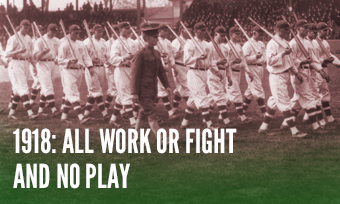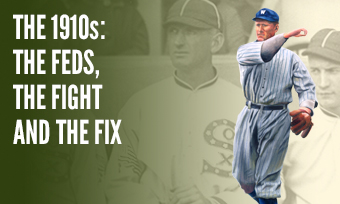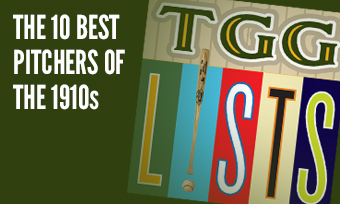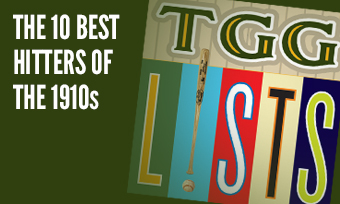The Yearly Reader
Leaders and Honors, 1918
Our list of baseball’s top 10 hitters and pitchers in both the American League and National League for the 1918 baseball season, as well as the awards and honors given to the game’s top achievers of the year.
The National League’s Top 10 Hitters, 1918
Bold type in brick red indicates league leader.
1. Edd Roush, Cincinnati
Key Numbers: .333 average, 18 doubles, 10 triples, 62 RBIs, 24 stolen bases, .455 slugging percentage.
Roush missed out on what would have been his second of three straight NL batting titles, falling two points shy of first-place Zack Wheat.
2. George Burns, New York
Key Numbers: .290 average, 80 runs, 135 hits, 22 doubles, 40 stolen bases.
It was a good year to be George Burns (see George Burns on the AL hitters’ list below).
3. Max Carey, Pittsburgh
Key Numbers: .274 average, 70 runs, 6 triples, 62 walks, 58 stolen bases.
Carey led the NL in steals as usual, but also led the circuit in walks for the first of two times in his career.
4. Heinie Groh, Cincinnati
Key Numbers: .320 average, 86 runs, 158 hits, 28 doubles, 54 walks, .395 on-base percentage.
In a year where the ball was as dead as ever, Groh used his infamous bottle bat to emerge as the closest thing to an all-around hitting force in the NL.
5. Sherry Magee, Cincinnati
Key Numbers: .298 average, 15 doubles, 13 triples, 76 RBIs.
The veteran star hitter made for a nice curtain call in Cincinnati by leading the NL in RBIs, even if it was only 76.
6. Charlie Hollocher, Chicago
Key Numbers: 131 games, .316 average, 509 at-bats, 72 runs, 161 hits, 23 doubles, 6 triples, 26 stolen bases.
The rookie shortstop led the NL in hits and gave the Cubs their only .300 batter.
7. Les Mann, Chicago
Key Numbers: .288 average, 27 doubles, 7 triples, 55 RBIs, 21 stolen bases.
Despite the shortened schedule, Mann—given the Cubs’ captainship in just his third year with the team—would set career highs in doubles, walks and steals.
8. Jake Daubert, Brooklyn
Key Numbers: .308 average, 12 doubles, 15 triples.
The two-time batting champ ended his nine-year tenure at Brooklyn in acrimony, suing owner Charles Ebbets for a breach of contract before being traded to Cincinnati.
9. Dode Paskert, Chicago
Key Numbers: .286 average, 69 runs, 132 hits, 24 doubles, 59 RBIs, 53 walks, 49 strikeouts.
The 37-year old led the NL in striking out—with 49.
10. Al Wickland, Boston
Key Numbers: 95 games, .262 average, 55 runs, 13 triples, 4 home runs, 53 walks.
The sparingly used but nevertheless productive Wickland, in his first major league activity since plying his trade for the Federal League’s Pittsburgh Rebels in 1915, had no doubles but six triples in 44 games played at Braves Field.
The American League’s Top 10 Hitters, 1918
1. Ty Cobb, Detroit
Key Numbers: .382 average, 83 runs, 161 hits, 19 doubles, 14 triples, 64 RBIs, 34 walks, .440 on-base percentage.
Cobb turned it up as the rest of baseball slowed down in preparation to close shop early, hitting .436 over his last 65 games.
2. Tris Speaker, Cleveland
Key Numbers: .318 average, 73 runs, 150 hits, 33 doubles, 11 triples, 61 RBIs, 64 walks, 27 stolen bases.
Spoke might have helped the Indians topple the Red Sox for the AL pennant, but he hit just .238 against his former team.
3. George Sisler, St. Louis
Key Numbers: .341 average, 69 runs, 154 hits, 21 doubles 9 triples, 45 stolen bases.
Playing in his last relatively lean offensive campaign, Sisler was still good enough to finish third in the AL batting race and first in steals.
4. George Burns, Philadelphia
Key Numbers: 130 games, .352 average, 178 hits, 22 doubles, 9 triples, 6 home runs, 70 RBIs, 8 hit-by-pitches.
Finishing as runner-up to Cobb for the AL batting crown after hitting .226 in 1917, Burns finally stole some limelight from the George Burns who starred for the Giants, and the George Burns who starred on Vaudeville.
5. Babe Ruth, Boston
Key Numbers: 95 games, .300 average, 26 doubles, 11 triples, 11 home runs, 66 RBIs, 58 walks, 10 intentional walks, 58 strikeouts, .555 slugging percentage.
Two of Ruth’s 11 triples were actually home runs that didn’t count since they were hit in extra innings with a man on first—rules then stipulated the batter being credited with only the amount of bases the lead runner needed to score. Still, it was the first of many home run titles for the Bambino.
6. Harry Hooper, Boston
Key Numbers: .289 average, 81 runs, 137 hits, 26 doubles, 13 triples, 75 walks.
Beyond all the above numbers, Hooper’s biggest contribution of the year might have been encouraging Red Sox brass that, “Hey, this Ruth kid—you should have him bat every day.”
7. Braggo Roth, Cleveland
Key Numbers: .283 average, 21 doubles, 12 triples, 59 RBIs, 53 walks, 8 hit-by-pitches.
The Indians suspended Roth for the rest of the season in mid-August for being out of shape—never mind that he hit .329 over the six weeks before.
8. Bobby Veach, Detroit
Key Numbers: .279 average, 139 hits, 21 doubles, 13 triples, 84 RBIs, 21 stolen bases.
Veach led the AL in RBIs for the third time and four years, and might have gotten to 100 RBIs had the season not been shortened by a month…
9. Ray Chapman, Cleveland
Key Numbers: .267 average, 84 runs, 19 doubles, 8 triples, 84 walks, 35 stolen bases.
…and the Cleveland sparkplug might have made it to double figures in both runs and walks.
10. Frank Baker, New York
Key Numbers: .306 average, 65 runs, 154 hits, 24 doubles, 6 home runs, 62 RBIs.
Now with the Yankees, Baker continued to play well (but without the spectacular verve) in his post-“Home Run Baker” era.
The National League’s Top 10 Pitchers, 1918
1. Hippo Vaughn, Chicago
Key Numbers: 1.74 ERA, 22 wins, 10 losses, 33 starts, 8 shutouts, 290.1 innings, 148 strikeouts.
The steady Cubs ace dominated the top of the pitching charts previously monopolized by war-bound teammate Pete Alexander.
2. Lefty Tyler, Chicago
Key Numbers: 2.00 ERA, 19 wins, 8 losses, 269.1 innings.
After solid but not spectacular results in eight years with the off-and-on Braves, Lefty righted his ship to the Cubs and produced his best year.
3. Wilbur Cooper, Pittsburgh
Key Numbers: 2.11 ERA, 19 wins, 14 losses, 3 saves, 273.1 innings.
After losing seven straight decisions to start the month of June, Cooper got more than even by reeling off eight straight victories.
4. Burleigh Grimes, Brooklyn
Key Numbers: 2.14 ERA, 19 wins, 9 losses, 40 appearances, 269.2 innings.
After suffering a miserable 3-16 mark with a rotten Pittsburgh team in 1917, Grimes escaped to Brooklyn and turned his luck around 180 degrees.
5. Fred Toney, Cincinnati-New York
Key Numbers: 2.43 ERA, 12 wins, 12 losses, 3 saves.
A tale of two teams and two seasons for the right-hander; he was 6-10 with a 2.90 ERA with the Reds, but then 6-2 with a 1.69 figure for the Giants.
6. Claude Hendrix, Chicago
Key Numbers: 2.78 ERA, 20 wins, 7 losses, .741 win percentage.
Second in the NL—and on the Cubs, behind Hippo Vaughn—in wins, Hendrix had his best year since winning 29 for the Federal League’s Pittsburgh Rebels.
7. Slim Sallee, New York
Key Numbers: 2.25 ERA, 8 wins, 8 losses, 132 innings, 12 walks.
Back issues ended Sallee’s season in mid-July and depressed his record even though he remained efficient; he walked less than one better per nine innings.
8. Pol Perritt, New York
Key Numbers: 2.74 ERA, 18 wins, 13 losses, 233 innings.
Perritt became the latest in a line of short-lived Giants aces; he would win just four more games over the next three years and never be heard from again in the majors.
9. Frank Miller, Pittsburgh
Key Numbers: 2.38 ERA, 11 wins, 8 losses, 23 starts, 14 complete games, 170.1 innings.
In his second-to-last season before taking a two-year exile from the game over salary disputes, the stingy right-hander compiled his best overall numbers.
10. Art Nehf, Boston
Key Numbers: 2.69 ERA, 15 wins, 15 losses, 28 complete games, 284.1 innings.
Nehf was forced to labor hard for a Braves team that hit just .244 and featured no other pitchers with 10 or more wins; a move to the Giants in 1919 would take care of those woes.
The American League’s Top 10 Pitchers, 1918
1. Walter Johnson, Washington
Key Numbers: 1.27 ERA, 23 wins, 13 losses, 8 shutouts, 326 innings, 162 strikeouts.
In posting the second lowest ERA of his legendary career, Johnson made up for a shortened schedule by pitching into extra innings nine times.
2. Stan Coveleski, Cleveland
Key Numbers: 1.82 ERA, 22 wins, 13 losses, 311 innings.
Stan became part of the first brotherly duo in the majors (after Harry in 1914) to each win 20 games.
3. Carl Mays, Boston
Key Numbers: 2.21 ERA, 21 wins, 13 losses, 30 complete games, 8 shutouts, 293.1 innings.
In his last full (and mentally benign) campaign for Boston—and the Red Sox’ last with a championship for 86 years—Mays emerged as the team ace.
4. Scott Perry, Philadelphia
Key Numbers: 1.98 ERA, 20 wins, 19 losses, 36 starts, 30 complete games, 8 shutouts, 332.1 innings.
With no other A’s pitcher winning more than eight games, it’s easy to see why manager Connie Mack fought tooth and nail to keep the controversial 20-game winner.
5. Allen Sothoron, St. Louis
Key Numbers: 1.94 ERA, 12 wins, 12 losses, 209 innings.
After losing 19 games in his rookie season the year before, the spitballer still didn’t get much of a break from his teammates in the won-loss column—even as he led the AL with an opposing .205 batting average.
6. Babe Ruth, Boston
Key Numbers: 2.22 ERA, 16 wins, 5 losses, .762 win percentage.
Before Shohei Ohtani in 2022, Ruth would be the only player ever to make it on both a Top 10 hitter’s and pitcher’s list in the same season.
7. George Mogridge, New York
Key Numbers: 2.18 ERA, 16 wins, 13 losses, 7 saves, 45 appearances, 239.1 innings.
Mogridge became Everyman for the Yankees, leading the team in innings and relief appearances (26).
8. Jim Bagby, Cleveland
Key Numbers: 2.69 ERA, 17 wins, 16 losses, 45 appearances, 271.1 innings.
Unspectacular yet respectable effort for the pitcher just two seasons away from hauling down over 30 wins.
9. Bullet Joe Bush, Boston
Key Numbers: 2.11 ERA, 15 wins, 15 losses, 272.2 innings.
Speaking of poor support, Bush got less than three runs per start while his Red Sox rotation mates each got over four. Thus, 15-15.
10. Reb Russell, Chicago
Key Numbers: 2.60 ERA, 7 wins, 5 losses, 19 appearances, 15 starts, 124.2 innings.
The still young (29) pitcher turned in a fine effort despite a fading arm; the tipping point would be reached a year later as his form collapsed. But he returned to the majors in 1922 reinvented as an outfielder—and a good-hitting one at that, batting .322 with 21 homers over two part-time seasons for the Pirates.









